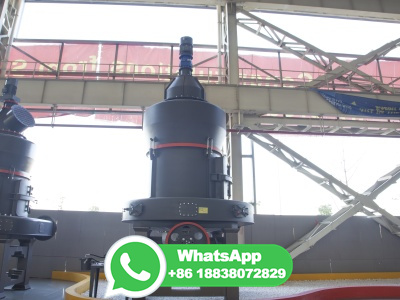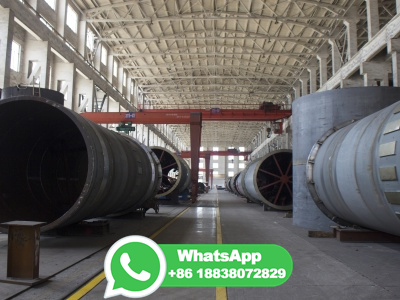
The Bayer process is a chemical process for refining aluminium hydroxide, Al(OH)3from bauxite; this aluminium hydroxide is subsequently calcined to produce alumina, Al2O3.
WhatsApp: +86 18838072829
The Preparation of Aluminum. The preparation of aluminum utilizes a process invented in 1886 by Charles M. Hall, who began to work on the problem while a student at Oberlin College in L. T. Héroult discovered the process independently a month or two later in France. In honor to the two inventors, this electrolysis cell is known as the HallHéroult cell.
WhatsApp: +86 18838072829
That changed with the independent discoveries of Charles M. Hall of the US and PaulLouis Toussaint Héroult of France in 1886. Hall and Héroult found a way to extract aluminum from alumina (aluminum oxide). The next year, Austrian engineer Karl Josef Bayer developed a process to extract alumina from bauxite ore.
WhatsApp: +86 18838072829
Science Chemistry The extraction of aluminum metal from the aluminum hydroxide found in bauxite by the HallHéroult process is one of the most remarkable success stories of 19th century chemistry, turning aluminum from a rare and precious metal into the cheap commodity it is today. In the first step, aluminum hydroxide reacts to form alumina (Al,0,) and water: 2A1(OH), (s) Al,0; (s) + 3 H,0 ...
WhatsApp: +86 18838072829
The Bayer HallHéroult process produces primary aluminium from bauxite ore. Initially, the Bayer process produces pure alumina (Al 2 O 3) by dissolving the raw bauxite ore in aqueous alkali solution. This is carried out at high pressure and temperature. Pure Al(OH) 3 is precipitated from the resulting solution, which allows separation of ...
WhatsApp: +86 18838072829
A large amount of alumina has to be produced in order to produce aluminum in the HallHéroult process; it requires about 4 t of bauxite to produce 2 t of alumina and it takes almost 2 t of alumina to produce 1 t of aluminum metal. The two largest operating costs per ton of alumina in Bayer plants are bauxite and fuel. Bayer Process
WhatsApp: +86 18838072829
ALUMINA PRODUCTION. Bauxite is crushed, dried and ground in special mills where it is mixed with a small amount of water. This process produces a thick paste that is collected in special containers and heated with steam to remove most of the silicon present in bauxites. The ore is loaded into autoclaves and treated with limecaustic soda.
WhatsApp: +86 18838072829
AlO (OH) + Na+ + OH + H2O → Al (OH)4 + Na+ Conditions within the digester (caustic concentration, temperature, and pressure) are set according to the properties of the bauxite ore. If bauxite ores have high gibbsite content, it needs to be processed at 140°C.
WhatsApp: +86 18838072829
Electrolysis is a process by which electrons are forced through a chemical cell, thus causing a chemical reaction. The positive charge usually attracts electrons, and the electrode providing electrons is called the cathode, because reduction takes place on it. Reduction always takes place at the cathode, by definition.
WhatsApp: +86 18838072829
Overall electrolytic reaction can be seen below:. 4A13+(1) + 602(1) → 4A1 (s) + 3O2(g). Aluminum is the third most plentiful element in the earth's crust, being found abundantly as trioxosilicates (IV) in rocks and clays. The main source of aluminum is the extracted from bauxite by electrolysis. The extraction proceeds in two stages.
WhatsApp: +86 18838072829
We have given equations, 1) 2 Al (OH)3 (s) Al2O3 (s) + 3 H2O (g) 2) 2 Al2O3 (s) + 3 C (s) 4 Al (s) + .. The extraction of aluminum metal from the aluminum hydroxide in bauxite ore by the HallHéroult process is one of the most remarkable success stories of late 19th century practical chemistry, turning aluminum from a rare and precious metal ...
WhatsApp: +86 18838072829
The Bayer process is used for refining bauxite to smelting grade alumina (Al 2 O 3), the precursor to aluminium. The process was developed and patented by Karl Josef Bayer 110 years ago, and has ...
WhatsApp: +86 18838072829
The substance Hall used was cryolite, Na 3 AlF 6, in which the Al 2 O 3 can be dissolved at just over 1000°C. Figure (PageIndex{1}): The Hall process. The electrolytic cell used for the Hall process. (Figure (PageIndex{1})) consists of a steel box lined with graphite. This contains the molten Na 3 AlF 6 and Al 2 O 3 and also serves as ...
WhatsApp: +86 18838072829
La bauxite est broyée puis mélangée à de la soude à haute température et sous pression. La liqueur obtenue, l'aluminate de sodium, est débarrassée de ses impuretés, puis diluée et refroidie, ce qui provoque la précipitation d'oxyde d'aluminium hydraté. Celuici est alors calciné pour obtenir l'alumine destinée à la ...
WhatsApp: +86 18838072829
Practice Problems: Q1. The fluoride ore of aluminium is referred to as _____ A. turquoise, B. bauxite C. cryolite D. feldspar, Answer: C. Solution: Cryolite, or Na3AlF 6, is an aluminium fluoride (Al 2 2 O) is an aluminium oxide ore. Feldspar (KAlSi3O 8) is an aluminium silicate, (AlPO 4 Al(OH) 2 O, is an aluminium phosphate ore.
WhatsApp: +86 18838072829
The mass of carbon anode consumed (giving only carbon dioxide) in the production of 270kg of aluminium metal from bauxite by hall processis ... in the production of 270 K g of aluminium metal from bauxite by the Hall's process is: 2 A l 2 O 3 + 3 C → 4 A l + 3 C O 2. Q. Acid reacts with metal carbonate to give carbon dioxide as one of the ...
WhatsApp: +86 18838072829
The Bayer process is used worldwide for the alumina production. This process involves the alkaline leaching of bauxite to extract Al, followed by the precipitation of Al(OH)3 to recycle the ...
WhatsApp: +86 18838072829
Aluminum is primarily produced by refining the bauxite ore to alumina in the Bayer Process, followed by electrolytic reduction to metal in HallHéroult process [].More than 95% of the global alumina production (134 million tons) in 2021 was from bauxite processed through the Bayer process [].The global reserves of bauxite ore are estimated between 55 and 75 billion tons and are sufficient ...
WhatsApp: +86 18838072829
On this day in 1886 Charles Martin Hall of Oberlin, Ohio, used an electrochemical process to make aluminum from aluminum oxide. Around the same time, Paul Héroult of ThuryHarcourt, France, independently discovered the same process. (In the photos, Hall is cleanshaven; Héroult is bearded.) Because of its high melting point, aluminum oxide is impractical to smelt by heat alone.
WhatsApp: +86 18838072829
Introduction. Primary aluminium production involves two independent energyintensive processes to transform the ore, which is bauxite, to the metal. These are the Bayer process (1888), which makes alumina from bauxite, and the HallHéroult process (1886), in which molten aluminium is produced by electrolytic reduction of alumina dissolved ...
WhatsApp: +86 18838072829
Corundum. There are a few forms of aluminum oxide, and corundum being the most common. The structure of corundum can be viewed as a hexagonal close packed array of oxygen atoms with 2 / 3 of the octahedral sites occupied by Al 3 + ions. Thus, the Al 3 + ions are bonded to 6 oxygen in a distorted octahedron. Each such octahedron share a face with one on the upper and one on the lower layers.
WhatsApp: +86 18838072829
The bauxite contained % Al 2 O 3, of which 37 % was present as boehmite, % SiO 2, all in kaolini te. The kinetic test was carried out at 100 o C in a liquor that contained g/L ...
WhatsApp: +86 18838072829
The Bayer process is used worldwide for the alumina production. This process involves the alkaline leaching of bauxite to extract Al, followed by the precipitation of Al(OH) 3 to recycle the solution [1,2,3].The leaching process results in the formation of a solid residue, commonly referred to as a bauxite residue, which consists of iron minerals, hydrous aluminosilicates, which are formed ...
WhatsApp: +86 18838072829
Transcribed Image Text: The extraction of aluminum metal from the aluminum hydroxide in bauxite ore by the HallHéroult process is one of the most remarkable success stories of late 19th century practical chemistry, turning aluminum from a rare and precious metal into the cheap commodity it is today. In the first step, aluminum hydroxide reacts to form alumina and water: 2 Al(OH)3(s)Al₂O3 ...
WhatsApp: +86 18838072829
Other articles where Bayer process is discussed: alumina: .extracted from bauxite through the Bayer process, which was developed for the aluminum industry in 1888. In the Bayer process bauxite is crushed, mixed in a solution of sodium hydroxide, and seeded with crystals to precipitate aluminum hydroxide. The hydroxide is heated in a kiln in order to drive off.
WhatsApp: +86 18838072829
The extraction of aluminum metal from the aluminum hydroxide in bauxite ore by the HallHéroult process is one of the most remarkable success stories of late 19th century practical chemistry, turning aluminum from a rare and precious metal into the cheap commodity it is today. In the first step, aluminum hydroxide reacts to form alumina and water:
WhatsApp: +86 18838072829
Question: Corrections The extraction of aluminum metal from the aluminum hydroxide in bauxite ore by the HallHéroult process is one of the most remarkable success stories of late 19th century practical chemistry, turning aluminum from a rare and precious metal into the cheap commodity it is today. In the first step, aluminum hydroxide reacts to form alumina and
WhatsApp: +86 18838072829
8 Citations Metrics Abstract This article gives a brief overview of the history of modern aluminium production, which started with the invention of electrowinning of dissolved aluminium oxide in molten cryolite (Na 3 AlF 6 )based electrolytes in 1886.
WhatsApp: +86 18838072829
Aluminum is mainly produced by two different methods: (I) a primary aluminum production from bauxite ore by the Bayer process for alumina extraction followed by HallHeroult electrolysis for Al ...
WhatsApp: +86 18838072829
The process stages are: 1. Milling. The bauxite is washed and crushed, reducing the particle size and increasing the available surface area for the digestion stage. Lime and "spent liquor" (caustic soda returned from the precipitation stage) are added at the mills to make a pumpable slurry. 2.
WhatsApp: +86 18838072829
The Bayer Process was patented in 1888 in Germany by the Austrian chemist, Karl Joseph Bayer [].The simple chemistry of the process is that the hydrated forms of aluminum in bauxite, readily dissolve in heated caustic (NaOH) solutions (the DIGESTION step, see Chap. 4).The advantage is that nearly all of the minerals in bauxite containing other metallic ions do not dissolve and so can be ...
WhatsApp: +86 18838072829
Question: The extraction of aluminum metal from the aluminum hydroxide in bauxite ore by the HallHéroult process is one of the most remarkable success stories of late 19 th century practical chemistry, turning aluminum from a rare and precious metal into the cheap commodity it is today. In. the first step, aluminum hydroxide 2Al(OH)3( s)→Al2O3( s)+3H2O(9) In the
WhatsApp: +86 18838072829
Aluminium ore close ore A rock containing enough quantities of a mineral for extraction to be possible. is called bauxite (Al 2 O 3).The bauxite is purified close purified A substance that has ...
WhatsApp: +86 18838072829
Alumina Extraction Problem. In the standard Bayer Process for refining bauxite to produce alumina, the dissolution of the alumina in the ore to form sodium aluminate is accomplished in autoclaves under high pressures varying from 70 to 200 pounds per square inch. However, some lateritic bauxite ores are readily soluble in caustic, making it ...
WhatsApp: +86 18838072829
Aluminum is extracted from its principle ore, bauxite. In Hall's process, molten cryolite and fluorspar are used to dissolve pure alumina. Balanced equations for the purification of bauxite by Hall's process: In Hall's process, the ore is fused with sodium carbonate followed by hydrolysis and heating.
WhatsApp: +86 18838072829